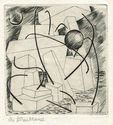
19th, 20th & 21st Century Fine Prints
707-546-7352 · fax 707-546-7924 · web: www.annexgalleries.com · email: artannex@aol.com
Roger Vieillard Biography
Roger Vieillard
French
1907–1989
Biography
Roger Vieillard was born in Mans, France on February 9, 1907 and was classically educated at the Sorbonne in Paris with a focus on literature and law, while also establishing himself as an internationally noted tennis player. He wouldn't become seriously interested in art until his conscripted service as a meteorologist with the French Army. Stationed in Morocco, he began sketching to pass the time. After his discharge from the army he discovered the wire sculptures of Alexander Caulder and began creating his own, beginning around 1930.
Vieillard continued to train and compete as a tennis player and, wanting financial stability, he took a position with the Banque Nationale pour le Commerce et l’Industrie as a financial analyst. He continued to draw and paint and in 1934 he met experimental printmaker Stanley William Hayter who, along with John Buckland-Wright, introduced him to the burin and how to create an "active line" on copper. He began working in the evenings at Atelier 17 and formed a close friendship with Hayter and Joseph Hecht. The success of his career at the bank, where he soon became chief financial analyst, allowed him to open his own press with artist Georges Lecoq-Vallon in 1939 where he published his first of many illustrated books, Apollinaire’s Salomé. Before long, he was championed by the livre d'artiste critic and collecor, W.J. Strachan.
In 1938 Vieillard married American painter and fellow Atelier 17 cohort Anita de Caro, with whom he would later collaborate; in the meantime, he continued to exhibit with Atelier 17 and work from his own studio. With the onset of World War II he was conscripted into the French army beginning in 1940. While mobilized, he began working on the manuscript for his novel, Les Rives du Scamandre, which wouldn't be published until 1994.
Once the war ended Vieillard was able to concentrate fully on his creative output, and he began exhibiting internationally. Over the next forty years Vieillard continued to create prints, both as unique artworks and as illustrations for his own livres d'artiste. His subject matter and style appeared to borrow somewhat from Piranesi, with imagery of fantastical architecture that often meditated on biblical and mythological scenes, executed in a surreal Precisionst manner. In the early 1960s he began to create “plaster prints”, a technique which had evolved at Atelier 17 in the 1930s. He retired as deputy director from the bank in 1967 and was elected president of the Société Peintres-Gravures Francais in 1970. Roger Vieillard died in Paris on March 1, 1989, shortly after his election into the Academie des beaux-arts.
Vieillard created over 600 prints between 1934 and 1989 and his work is represented in museums in France and the Museum of Modern Art and the Metropolitan Museum in New York.





